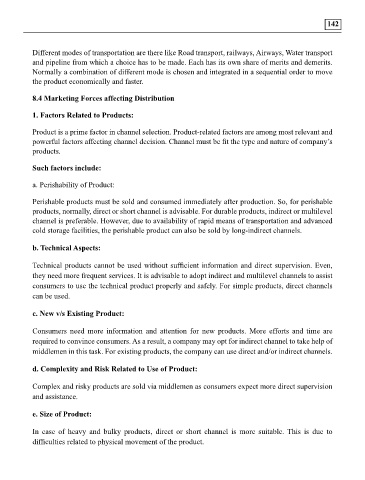Page 142 - Warehouse 1 to 9
P. 142
142 143
Different modes of transportation are there like Road transport, railways, Airways, Water transport f. Divisibility of Product:
and pipeline from which a choice has to be made. Each has its own share of merits and demerits.
Normally a combination of different mode is chosen and integrated in a sequential order to move Mostly, indivisible products are distributed directly to customers. Divisible products can be
the product economically and faster. conveniently distributed by middlemen.
8.4 Marketing Forces affecting Distribution g. Unit Price of Product:
1. Factors Related to Products: Precious products, like gold, jewellery, certain chemicals, software, etc., are distributed using
direct or short channels of distribution. Use of direct and short channel can minimize risk of theft
Product is a prime factor in channel selection. Product-related factors are among most relevant and or robbery.
powerful factors affecting channel decision. Channel must be fit the type and nature of company’s
products. h. Legal Aspect:
Such factors include: Quite obviously, permitted (legal) products can be distributed by any convenient channel of
distribution. But, illegal products are distributed by direct channels for secrecy purpose.
a. Perishability of Product:
2. Factors Related to Company:
Perishable products must be sold and consumed immediately after production. So, for perishable
products, normally, direct or short channel is advisable. For durable products, indirect or multilevel Company’s internal situations have direct impact on choice of marketing channel. Manager has to
channel is preferable. However, due to availability of rapid means of transportation and advanced analyze company-related factors to decide the best fit channel(s).
cold storage facilities, the perishable product can also be sold by long-indirect channels.
Company-related factors include:
b. Technical Aspects: a. Company’s Financial Position:
Technical products cannot be used without sufficient information and direct supervision. Even, Financially sound companies can maintain separate and well-equipped departments for distribution
they need more frequent services. It is advisable to adopt indirect and multilevel channels to assist of products. Such companies can open and manage own retail outlets and can hire salesmen to
consumers to use the technical product properly and safely. For simple products, direct channels manage distribution effectively. They do not require services of middlemen and, hence, can
can be used. distribute the product directly. But, financially weak companies have to opt for indirect channels to
share resources and expertise of channel members.
c. New v/s Existing Product:
b. Product Mix of Company:
Consumers need more information and attention for new products. More efforts and time are
required to convince consumers. As a result, a company may opt for indirect channel to take help of A company’s product mix consists of product lines and product items in each product line. Many
middlemen in this task. For existing products, the company can use direct and/or indirect channels. product lines and several product items/ varieties in each of the product lines can enable the firm
to offer multiple choices to a large number of consumers. Even, the firm can take benefit of the
d. Complexity and Risk Related to Use of Product: scale of economy. In such case, direct channels are more advisable. Small companies with limited
product lines and/or product items should distribute products via wholesalers and retailers, who sell
Complex and risky products are sold via middlemen as consumers expect more direct supervision products of many companies.
and assistance.
c. Desire for Control:
e. Size of Product:
If a company desires to have direct and close control over production and selling activities, direct
In case of heavy and bulky products, direct or short channel is more suitable. This is due to channels are preferred and vice-versa.
difficulties related to physical movement of the product.

